We’re all multiple – Legion Theory and my DID team
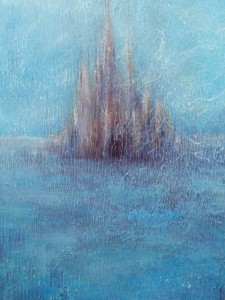 According to Legion Theory we are all multiple. The only difference is that most people have integration of their parts into the whole which presents as ‘one self’. To use some analogies, their ‘quilt’ is not a patchwork quilt. Their ‘vase’ is not glued together, it was and remains a little chipped, a little touched up, but it is whole. Dissociative disorders can effect any of us at any time given extreme enough circumstances and the right predispositions.
According to Legion Theory we are all multiple. The only difference is that most people have integration of their parts into the whole which presents as ‘one self’. To use some analogies, their ‘quilt’ is not a patchwork quilt. Their ‘vase’ is not glued together, it was and remains a little chipped, a little touched up, but it is whole. Dissociative disorders can effect any of us at any time given extreme enough circumstances and the right predispositions.
How extreme and long lasting these dissociative disorders may be depends on a range of things:
* How predisposed we are (personality traits, brain injury, developmental disabilities),
* How developmentally vulnerable (younger) we were at the time,
* How extreme these circumstances,
* Did we live with the abuser/s (no sense of safety or reprieve),
* How socially vulnerable we were (did we also have healthy and available carers)
* Whether we experienced continual retraumatisation compounding the original damage,
* Did we receive any ongoing intensive therapeutic interventions to address the damage and change the damaging circumstances.
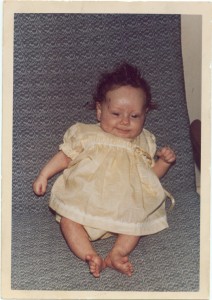 I was born in 1963 to an alcoholic mother, experienced brain injury and was diagnosed in 1965 as a psychotic child at the age of 2 in an era when autism was deemed ‘infantile psychosis’.
I was born in 1963 to an alcoholic mother, experienced brain injury and was diagnosed in 1965 as a psychotic child at the age of 2 in an era when autism was deemed ‘infantile psychosis’.
I grew up in a chronic fight flight state, developed alters since I was 2 years old, had treatment for PTSD in my teens, 20s and 30s and was diagnosed with Dissociative Identity Disorder in 2010 aged 46. By the end of that year my Core Self – the original sense of self from which the 15 others split off – ‘woke up’ from chronic depersonalisation, derealisation and dissociation from the body, mind and emotions… essentially a ‘psychological coma’. I had been gone for 44 years, watching my alters live the life I never had as if I were a ghost watching their lives. But i was not a ghost and upon return to the body, mind, emotions, took charge of this disparate ‘team’, helped them know, understand, and live respectfully and harmoniously with each other to a point we achieved ongoing co-consciousness and presently semi integration.
As part of this journey I had to unravel many secrets, stories, perspectives on the ‘one life’ this body had been through with different ‘drivers’. Each part of me had its own abilities and challenges, perspectives and beliefs, investments and triggers. They had different ages, genders, cultures, orientations, histories, attachments, identifications, and three of the earliest ones identified as animals and three more identified as ghosts possessing the body. Some had no sense of family relationship to my father, mother, older brother, younger brother. Some felt they had one brother or the other but not both, one parent or the other but not both, and some felt they had family other than my immediate biological family or had no family at all.
Some of them were out of the body (Katrina) but haunted others in the team (Katrina haunted Anne, I watched everyone but other times was simply ‘dormant’). Some of them were ‘room children‘ (Willie, Anne, Esby and later Polly) meaning they only came fully into the body when nobody else was present with us. Some of them were only outside of the house (Shirley) or came out far more outside of the house than in the house (Da, Marnie, Lee) or came out around Italians (Rose). Two were consistently in the house but could also appear when outside of the house (Carol, Addie).
MY TEAM:
I went dormant before age 2, largely upon the loss of Sister Jelly and the welfare centre’s program for ‘at risk’ infants that had had me Mon-Fri 9-5 from 6 months old until two and a half. Suddenly, all of that structure, routine, safety, was gone and I just couldn’t transition so I couldn’t stay in the body, mind, emotions. I went ‘dormant’. I continued to ‘record’ much of what happened to parts of me left behind, many of whom also then developed alters. In this sense I fitted what is known as an Inner Self Helper (ISH). Upon my return I also took over as Manager from Willie.
Another part of me remained from the age of 2 – Esby. Meaning deaf, meaning blind and face blind, Esby was in the body but did not form emotional attachments and didn’t develop ‘mind’. As such, Esby’s world was completely sensory, pleasure seeking, and non verbal. Esby communicated with movements and sounds and navigated daily life like a ‘feral child’.
ESBY:
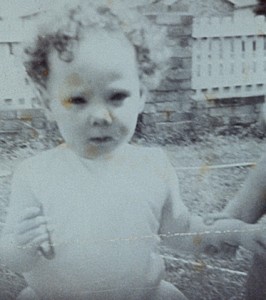 Esby identified with the rabbit (Foosh), the cat (Ning) and the dog – Animal Alters. In developing parts of herself as each of these animals these ultimately functioned as separate entities. The cat and rabbit remained what they had been and the dog became a dog-lion-bear which ultimately we named Opie. At the same time our paternal grandparents lived in the shed in our backyard (had lived with us since before our birth) and around the age of 2-3 they developed a healthy family relationship with Esby which encouraged connection and curiosity (mind). Esby felt safe with objects, not people. She split, from which came Polly.
Esby identified with the rabbit (Foosh), the cat (Ning) and the dog – Animal Alters. In developing parts of herself as each of these animals these ultimately functioned as separate entities. The cat and rabbit remained what they had been and the dog became a dog-lion-bear which ultimately we named Opie. At the same time our paternal grandparents lived in the shed in our backyard (had lived with us since before our birth) and around the age of 2-3 they developed a healthy family relationship with Esby which encouraged connection and curiosity (mind). Esby felt safe with objects, not people. She split, from which came Polly.
Esby remained ‘hidden’ throughout our lives. Often thought of as a ‘regressed form of Polly’, she was not recognised in her own right until we were in therapy in 2010. It was when Polly began teaching Esby the names of things and how to form sentences that we realised that these two had been completely divided and were now connecting back with each other. Esby remains the most ‘classically autistic’ of the team. She is fun and funny and warm and has come so far. Having connected with Polly, she has developed some level of simple verbal communication and great enjoyment most particularly of our husband Chris, who Polly sees as ‘Pop’ and who Esby therefore sees as our safe person ‘Bop’. Esby still largely never appears around others. Because she still largely communicates and interacts in sounds and movements, when she come back into the body around others, most people might consider ‘me’ to be ‘stimming’ or having ‘Tourette’s tics’.
Esby liked our father, had no relationship to our mother and knows this mother was disability phobic and disgusted by having a child like Esby. Esby remembers the paternal grandparents fondly. She knows her biological family have two sons. She knows that neither know her or accept her as she is. Luckily, she’s not bonded enough with them to need them to accept her. Esby remains a Little.
Esby’s alters were: FOOSH, NING, OPIE, POLLY.
POLLY:
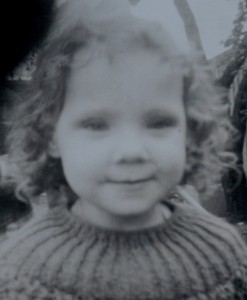 Polly was cheery, sunny, the loved grandchild of the grandparents in the home of their shed in the back yard and at home with our father who doted on her, particularly making her laugh, dance, encouraging play. Polly had self directed echoed speech which was self chatter. Polly loved music and records and began to sing to herself all the time. It gave a semblance that we would be able to speak. But interactively, other than repeating back phrases, Polly lacked interactive speech. Polly continued to split into Esby as well as into the animals – Foosh, Ning and Opie. In addition, around age 2-3 she developed a protector alter – Willie. And at age 4 she developed an ‘imaginary friend’ – Carol – who ultimately became an alter. Polly went ‘dormant’ around age 4 and a half. Out of this came Anne.
Polly was cheery, sunny, the loved grandchild of the grandparents in the home of their shed in the back yard and at home with our father who doted on her, particularly making her laugh, dance, encouraging play. Polly had self directed echoed speech which was self chatter. Polly loved music and records and began to sing to herself all the time. It gave a semblance that we would be able to speak. But interactively, other than repeating back phrases, Polly lacked interactive speech. Polly continued to split into Esby as well as into the animals – Foosh, Ning and Opie. In addition, around age 2-3 she developed a protector alter – Willie. And at age 4 she developed an ‘imaginary friend’ – Carol – who ultimately became an alter. Polly went ‘dormant’ around age 4 and a half. Out of this came Anne.
Polly would occasionally ‘awaken’ throughout our later childhood, teens and adulthood. When this happened she would still be 4 years old, stuck in the 1960s, often sunny, playful, but then quickly disoriented and triggered into PTSD when she couldn’t reconcile that she was not 4 and this was not the 1960s, then she’d go dormant again.
She emerged quite a lot around 2000 to the present once we had married our husband Chris. She would call him ‘Teddy’ and ‘Teddy-Pop’ and saw him as the reincarnation of her paternal grandfather’s spirit. Chris had married several of the team, most especially perhaps Anne, and adored Polly, which was utterly mutual.
In 2010, upon my awakening and return to the body, Polly asked one of her alters, Carol, about me, saying inside ‘is she God’? I heard Carol reply to Polly, ‘no, I think she thinks she is going to be our mother’. Polly did not feel familiar with me, didn’t think I was fun, but over time accepted me as her ‘house parent’ and this allowed us to ultimately dialogue and I was able to help counsel her about what DID was, what an alter was, what had happened to her and PTSD, and help her come to terms with brain injury and learning disabilities, with being in an adult body (including going through intensive and challenging cancer treatment in 2011). Polly has become a great helper in the team. She enjoys characterising, dressing up, communication via representational objects, painting, gardening, games, walking, animals, singing, music, cooking, silly dancing, adventure playgrounds and misses 1960s cartoons and sit coms. She would still probably strike outsiders as ‘developmentally delayed’. Polly remains a Little.
Polly recognises her paternal grandparents as her true parents. She recognised our father as her ‘Dad’. She recognises our mother only as our abuser and has no valued memories of her. She knows this abuser had two other children but does not feel at all related to the older brother and thinks the younger brother is ‘an ok person’ but doesn’t feel familiar with or bonded to him.
Polly’s alters were: WILLIE, CAROL, ANNE, DA, ROSE (of which she was only aware of Willie and Carol).
WILLIE:
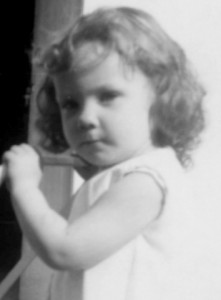 When Polly was 2-3 years old, our mother put Polly into burning hot baths, she had a washcloth stuffed into her mouth and been whipped across the face until she vomited out of her nose, being shut in the room much of the day, had regular terrifying whippings to the point her body went into shock and she couldn’t breath, was tied to the bed and abused, and endured episodes of strangulation and suffocation abuse at night. During this time Polly was given bottles of cold milk that contained gin and Valium and our father was told this was ‘to stop her screaming all the time’.
When Polly was 2-3 years old, our mother put Polly into burning hot baths, she had a washcloth stuffed into her mouth and been whipped across the face until she vomited out of her nose, being shut in the room much of the day, had regular terrifying whippings to the point her body went into shock and she couldn’t breath, was tied to the bed and abused, and endured episodes of strangulation and suffocation abuse at night. During this time Polly was given bottles of cold milk that contained gin and Valium and our father was told this was ‘to stop her screaming all the time’.
As a result of the suffocation abuse Polly ‘discovered’ a protector alter, Willie. Willie came to endure the abuse for her. Willie experienced himself as a ghost who hovered outside of Polly but took over the body when she dissociated.
It was only recently that we understood that there was a time before Willie was an alter where Willie was that part of us that our paternal grandfather would take to the park at the end of the street, quietly watch over and who called us ‘Willie’. This grandfather, Henry Roy Bonnell, lived with our grandmother Ruby Sherwell, in a shed in our back yard, and lived under the name Harry Williams. But he had had a different life, a different world before he’d ever got with our lovely but simple bag-lady grandmother, a world before he was a swaggie for 14 years following World War 1. Our grandfather had been a 21 year old father with a wife and a three year old daughter in 1916, a daughter named Williamina – Willie. He’d gone to fight in Villers Bretonneux and returned to find his wife had more children. He never saw them again. This quiet, private, serious, responsible, moral, solitary man had taken us to the park between the ages of 2-4, watched us, modeled and reinforced an inquiring mind and didn’t call us Polly as he did when he was with our grandmother at home in the shed. Out together in the park, perhaps because he was back in time, the young father he once was, he called us Willie. And the part of us that was Polly remembered Pop in the shed, not who he was at the park. So when she was in desperate need she called up a part of herself and later presumed Willie was some kind of a ghost. And in time, with nobody reminding or reinforcing the memories of our grandfather at the park, Willie too had no idea where his identity, nature, passion for learning, equality, morality, responsibility, seriousness, solitude, and protector nature had originated from. It had appeared to have ‘fallen out of thin air’. But it actually hadn’t.
As an alter, Willie experienced himself not as the quiet, serious child he had been at the park with our grandfather. As an alter, Willie experienced himself not as a child at all, but as an adult male. This was the part of the team who applied himself with fierce single-minded determination to gaining the one-word-one-meaning system of language that enabled us to acquire functional speech from age 9-11. With this came a fairly sudden and progressive ‘birth of mind’, a realisation of concepts, categories, connections. In some ways this could have been viewed as a transition from a more ‘autistic’ reality into a more ‘Aspie’ one. By the age of 18 developed into a quite Schizoid, rather ‘Aspie’ adult with stilted social skills, an encyclopedic mind, a great passion for learning and achievement as has been jokingly referred to as ‘Doctor Donna’ and ‘the walking encyclopedia’.
Willie returned to education when we were 18, overcame being innumerate and illiterate, and saved us from homelessness and exploitation. Willie went on to gain us a degree in Linguistics, an honors degree in Sociology, a post graduate diploma in Education, co-authored our first book, Nobody Nowhere, wrote all of our text books, became an international public speaker, lecturer and autism consultant. In 2010, when we were 46, Willie learned ‘he’ was an alter and would work with me to help me become the team leader, the glue to bring the team together. Willie would have fitted what is referred to as an Observing Emotional Part (OEP), a Protector, and also functioned as a Manager Alter until I returned.
Willie feels unrelated to any of our biological family members. Willie feels an older brother to Polly, Carol and Da. Willie did not feel related to the rest of the team.
Willie has no alters.
ANNE:
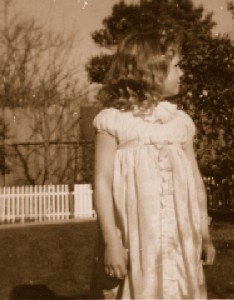 When we were 3, in spite of never having been abused by him, our abuser banned our father from looking at, speaking to or picking Polly up. She still had the paternal grandparents outside. Then the grandfather died suddenly when Polly was 4 and a half and the grandmother was sent 100 miles away the same week. Polly went into a mixture of deep grief and shock. This new state felt like a ‘ghost’, older than Polly, mute, imploded, completely avoidant and private and became an alter known as Anne. Anne was ‘the keeper of ghosts’. She kept sacred all the movements, voices, smells of our paternal grandparents so that they were not ‘lost’. She separated ‘our world’ from ‘the world’ and this became ‘law’. Anne would have presented as ’emotionally autistic’, in a state of autistic withdrawal, and selectively mute.
When we were 3, in spite of never having been abused by him, our abuser banned our father from looking at, speaking to or picking Polly up. She still had the paternal grandparents outside. Then the grandfather died suddenly when Polly was 4 and a half and the grandmother was sent 100 miles away the same week. Polly went into a mixture of deep grief and shock. This new state felt like a ‘ghost’, older than Polly, mute, imploded, completely avoidant and private and became an alter known as Anne. Anne was ‘the keeper of ghosts’. She kept sacred all the movements, voices, smells of our paternal grandparents so that they were not ‘lost’. She separated ‘our world’ from ‘the world’ and this became ‘law’. Anne would have presented as ’emotionally autistic’, in a state of autistic withdrawal, and selectively mute.
Around age 9, others in the team had started typing letter strings which then became word lists by age 10, and soon Anne began to use this new typed communication to type poetry. Anne remains a wonderful poet and although she ultimately came to speak, typing is by far her preferred communication.
Anne emerged with very few people, primarily only with our musician and singer friend Scott (‘Tim’ in Nobody Nowhere) when we were around age 22. Anne had a strong bearing on Nobody Nowhere, which largely contains input from Anne (referred to there as Donna), Willie, Carol. She then reappeared with our husband Chris when we were 37 and felt instantly connected with him and ‘home’. Anne remains more bonded with Chris than anyone else. In our 20s Anne composed classical music and began painting. In our 30s Anne became a sculptor and in our 40s began doing faceless figurative paintings which has now sold all over the world.
Anne feels she is the orphan child of her paternal grandparents. She had little relationship to our father, remembers our mother only as an abuser, and has no relationship with either of our brothers. Anne feels a sister to Addie and had a spiritual connection with Katrina. Anne would disappear when attacked or degraded, leaving Addie in her place. Anne was a Gatekeeper holding the memories of our grandparents for Polly who ‘died’ at age 4 and didn’t return until our 20s, then our 30s.
Anne’s alters: ADDIE.
CAROL:
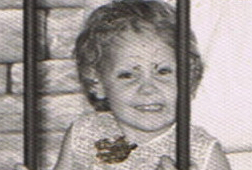 At age 4-5, our mother saw Polly as a trainable doll which would learn to ‘act normal’ or be killed. As a result, Polly developed a fixation with children on TV and unconsciously began mirroring them (echopraxia, echolalia). When she met a non autistic girl at the park who took her home, she later was characterising this girl at the mirror and so believe it WAS that girl, who Polly named Carol. Carol became the school child who could mirror non autistic children (like the girls on TV) and although still echolalic until age 9-11, could be accommodated within a specialised program within a mainstream school(C.I.R was a ‘Country Infant Room’ established to enable trainee teachers to complete their required training under the guidance of experienced primary teachers. There were 6 students Carol’s age and we’d be with the same teacher in the same room for 3 years). Carol was dealt with by the Psych and Guidance team and labelled ‘disturbed’.
At age 4-5, our mother saw Polly as a trainable doll which would learn to ‘act normal’ or be killed. As a result, Polly developed a fixation with children on TV and unconsciously began mirroring them (echopraxia, echolalia). When she met a non autistic girl at the park who took her home, she later was characterising this girl at the mirror and so believe it WAS that girl, who Polly named Carol. Carol became the school child who could mirror non autistic children (like the girls on TV) and although still echolalic until age 9-11, could be accommodated within a specialised program within a mainstream school(C.I.R was a ‘Country Infant Room’ established to enable trainee teachers to complete their required training under the guidance of experienced primary teachers. There were 6 students Carol’s age and we’d be with the same teacher in the same room for 3 years). Carol was dealt with by the Psych and Guidance team and labelled ‘disturbed’.
Carol was sunny, very ‘Pollyanna’, heart-driven, sensitive, kind and a pleaser. This fitted in well with becoming our mother’s ‘dancing doll’ and Carol would endure extreme levels of ballet practice, physical contortions (our mother wanted a contortionist and a world class ballerina). Carol bought the continual indoctrination that she was ‘lucky’ because she had dolls, dancing lessons, ballet tutus, ballet shoes, fancy wallpaper, nice furniture, and later chandeliers in her designer bedroom. Carol tolerated the destruction of her toe joints put into padded out pointe shoes at just 7 years old. At age 7 Carol achieved 98% in her 2nd ballet exam, earning a scholarship our mother immediately ‘generously’ gave away to the Italian mother of a younger, skilled dancer who was the dance teacher’s pet on the basis ‘they needed it’. Carol performed in the dance concerts, our mother the iconic stage mother among the other stage mothers fussing over their daughters with make up and hair spray, competing, preening.
It was very ‘Mummy Dearest’ and Carol made gratitude her religion. As strangers were continually shown her belongings, her room, her abilities as proof of how ‘lucky’ she was, she learned to think, live and breathe this belief she was ‘lucky’. When she failed to do so, she had her hair cropped off to a crew cut, her clothes taken off and her older brother dressed in them with only her brother’s clothes to wear. Carol’s alter Addie took this sort of abuse on her behalf which allowed Carol to maintain the ‘sunny’ nature that our survival equally depended upon.
In the first three years of primary school, Carol experienced emotional and physical bullying from two children, then significant social isolation for many years, and then more bullying in the last two years of primary school.
Eternally around 7 years old in her psyche, Carol was echolalic until age 9-11, a poor learner, with poor impulse control and was eventually left up the back of the classroom for singing or chattering which was deemed constant distraction for those there to learn. As such she commonly experienced segregation and exclusion she could not fathom. She has experienced herself as ‘tolerated’ in mainstream environments, regularly mistook ‘friendly’ for ‘friends’ only to find herself being mocked and discarded by those she thought liked her. Unable to recognise anyone out of context she couldn’t adhere socially, struggled to tell familiar from stranger and so was indiscriminately friendly with associated consequences. Out of this developed social anxiety and over compensated which only further endangered her. Carol would have presented as ‘high functioning autistic’ with a semantic pragmatic language disorder and mild learning disabilities.
Easily groomed, Carol became sexually assaulted at age 8, raped at age 12, then again at age 14, was groomed by a pimp at 15 (fortunately Willie took over and ran away), then accepted ‘domestic prostitution’ from age 15-21 to stay off the street. This left Carol confused about love, relationships, sex and it has taken a lot of work to rehabilitate Carol from this impact. Carol still understands all this within a 7 year old’s framework.
She was close to a few girls throughout out first 3 years in secondary school from 12-14, including our ‘foster sister’ Dee (Robyn in Nobody Nowhere), largely connecting through singing, music, skating and clothes. In our teens, between 15-18, Carol became a machinist, shop assistant, kitchen hand and worked as a car cleaner for our father at his car yard. In our teens she befriended neighbors and shop keepers. In our 20s, as Willie was an A student at university, Carol was a volunteer with a foster care agency, a home visitor to elderly people and helped out in an information service, was involved in song writing with our friend Scott and concentrated on recording songs.
Carol was a co-author of Nobody Nowhere. After its publication Carol was labelled (and invalidated) by Willie (now host) as’one of our defences’ and suppressed, no longer being a major host presenting in the body. She eventually made her first album as a singer songwriter around 1998 and was involved in a second one around 2005. She enjoyed performing in rock musicals with the Aspinauts in 2009 and in 2012 was among the team which joined a choir. Since 2013, together the team, she enjoyed being part of teaching art and drama. She adores our cats, Mini and Max. She adores Chris, thinks he is the perfect family. Upon my ‘awakening’ in 2010, Carol needed a lot of help to understand PTSD, DID, her place as an alter, to face that it was ok that she didn’t actually feel ‘lucky’ as a narcissistic object, that she detested being a doll and why she had got stuck at age 7.
Carol is an Introject Alter who is a composite of friendly motherly young women from 1960s TV sit-coms: Patty from Patty Duke Show, Lisa and Sue from Adventure Island, Maryann from Gilligan’s Island, Ellie-Mae from Beverly Hillbillies, Jan and her mother Carol from The Brady Bunch all of which provided her with a vast range of internal modelling. Later she introjected the only other same age peer in our first three years at primary school – Linda. Together these introjections produced a friendly, romantic, cheery, kind girl whose entire job was to have some sense of social normality. She is also a Slider Alter, moving between being a Little and a Middle Alter.
Carol feels older sister to Polly, same age sister to Rose and Da, younger sister to Addie and Willie. Carol recognises and values our father as her ‘Dad’, recognised our mother as her mother who is ‘broken’ (and so she needed other mothers), recognises our brothers as her brothers.
Carol’s alters include: ADDIE.
DA:
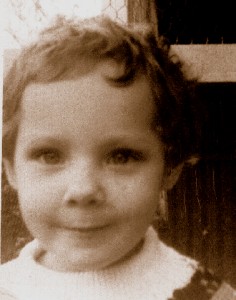 As Polly was developing, so was Rose and Da. Our father was usually great with Polly but at other times he was too full on. He was rather schizoaffective/bipolar (medicated with Valium and Tryptonol) which meant his rough and tumble was sometimes terrifying. He’d grab Polly, put her on his shoulders and run full speed through the house. He’d swing her by the hands but let her go, sometimes landing on the bed, sometimes not. He would sometimes suddenly drive like an insane racing driver with a dodgem car with Polly in terror. He would keep us safe from our abuser by taking us out all night in the car with him but he’d leave Polly in the car, warm enough wrapped up in his coat, but afraid and abandoned in the car. Out of this came a boy, Da, who was resilient, wild, fearless, and could endure our father’s bipolar whilst loving him as his Dad.
As Polly was developing, so was Rose and Da. Our father was usually great with Polly but at other times he was too full on. He was rather schizoaffective/bipolar (medicated with Valium and Tryptonol) which meant his rough and tumble was sometimes terrifying. He’d grab Polly, put her on his shoulders and run full speed through the house. He’d swing her by the hands but let her go, sometimes landing on the bed, sometimes not. He would sometimes suddenly drive like an insane racing driver with a dodgem car with Polly in terror. He would keep us safe from our abuser by taking us out all night in the car with him but he’d leave Polly in the car, warm enough wrapped up in his coat, but afraid and abandoned in the car. Out of this came a boy, Da, who was resilient, wild, fearless, and could endure our father’s bipolar whilst loving him as his Dad.
Da was a climber, could scale the doors in the house, cupboards, trees, fences, and get up on rooves without fear. To Da the more exciting, the more dangerous, the more enticing. To get higher, go faster, jump further… everything was a challenge, rising to challenges was the stuff of life and everything had to be made exciting, fun, silly and surreal. At age 6-7 Da was going over fences in the neighborhood, meeting new children and being a feral, monkey-like child.
Da was fixated by escape, loved Houdini, and remembers being repeatedly tied up by our older brother from around age 4-7. Da took pride in capacity to escape. It was like his life blood and it probably was a remnant of Polly’s survival being regularly tied to the bed by our abuser. In this sense, Da was our hope, he was ‘Wendy’s Peter Pan’.
At our father’s car yard, where we were routinely dropped off for childminding from around age 3-9, Da would get up on his office roof, rifle through the traded-in (mostly stolen) goods in his shed, shred his receipt books and calendars and try and toss things into the fire in his incinerator. In response our father would ‘put Da to work’, constantly keeping him busy with simple jobs. Our father taught Da how to clean windows, wash cars, clean seats and later how to help with sanding cars, even taught Da how to help change tyres, break pads, clean spark plugs and bitumen the roof of his office. Da, who was also dyslexic, would have fit a classically ADHD/bipolar picture.
In our 4th year at primary school, aged around 8, we moved from the hands on and rote learning of the ‘Country Infant Room’ we’d been in with only 6 same age peers for 3 years with the same room and same teacher, into a usual classroom of around 35 same age students. We were dealing with long bouts of bronchitis and associated Strep related Tourette’s tics. Carol went dormant and, overstimulated, Da emerged chronically out of control with chronic throat clearing and coughing tics (as well as vocal tics). For around 30% of the school year Da was sent to stand out in the cold concrete corridor with two other ‘unteachable’ boys for large parts of the day. Like most ADHD-type boys, this simply entrenched Da’s compulsive non conformity and built his self entertainment abilities.
At home, Da was big brother to our younger brother, giving him aeroplane spins, jumping on beds together, climbing, posting himself and his younger brother headfirst down the stairs. Da put on puppet shows, did characterisations, did magic tricks. Da was the constant entertainer, magician.
Da went through four high schools before leaving, innumerate and illiterate at the age of 15 and did homelessness from age 12-15 as if it were all an adventure and challenge in endurance. Da was a speed skater, did clowning and was quite a gymnast. On the less constructive side, Da got drunk with drunks, stoned with stoners and disappeared whenever anything was too heavy, too sad, too confusing. Da went largely dormant when Willie returned to education, though returned now and then to write a satirical song, write some blues, or party before disappearing again. At 26 Da appeared for a while in the UK as a stand up comedian then disappeared when he became recognised by a well known UK comedian and given a paid slot as support act.
Upon publication of Nobody Nowhere, Da appeared now and then to enjoy the sights and sounds of foreign hotels and streets, to collect languages and try new food. Da spent time in a 3 year lesbian relationship in our 30s and contributed to all of our music albums, the formation of The Aspinauts, our performances in rock musicals in 2009, the writing of two children’s books, our spray art ‘Neoteric’ works which have sold around the world. Da would break through during our lectures and do hilarious characterisations which were received so well that he and Willie became a team with Willie delivering all the ‘important’ information and Da demonstrating with charicature style characterisations. With Willie as an autism consultant, Da was great with autistic children and progressively a funny and entertaining teacher.
Da arrived during the wedding ceremony to Chris and has enjoyed our marriage and sees Chris as a ‘great pal’. Da has encouraged Chris where anxiety would usually have stopped him, has cheered him out of depression and taught him to laugh at himself.
Upon my return to the body, Da was the most enthusiastic and excited. Da welcomed me wholehearted as if to say, ‘thank goodness you’re here, this lot sure need a houseparent’. I struggled with all kinds of functioning for the first 3-6 months and Da coached me, encouraged me, in everything from executive functioning, to filling me in on how to troubleshoot and, most importantly, how to speak (I had a severe stammer so thought I couldn’t speak). For my part, I helped Da understand and come to terms with being female, how to stop taunting Carol, how to be helpful and not sabbotage. Da was in part an Introject of our rather bipolar father from our early years.
Da remains our designer, our DIY person, our entrepreneur, a resident artist, composer, blues singer, satirist (quite the Tim Minchin), surrealist, musician, and the ‘can do’ of the team.
Da sees Carol as his little sister, Marnie as his same age sister, Willie as his older brother and has been learning to be a respectful brother to Addie. Da was bonded with our father as his ‘Dad’, has no positive memories of our mother and does not consider her as ever having been capable of being his mother, has a sense of our older brother as ‘someone who lived in the house’, and a strong bond with our younger brother as his ‘little brother’.
Da has no alters.
ROSE:
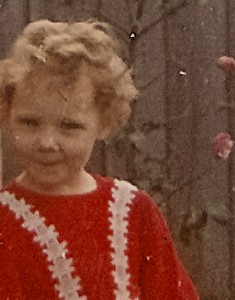 From 6 months old to 7 years old we lived in a small dead end street (with a park at the end). By the age of 2-3 when we could walk to the park at the end of the street (yes we took ourselves, also our grandfather would take us). Rose was not Anglo Australian at all and did not belong to our biological family.
From 6 months old to 7 years old we lived in a small dead end street (with a park at the end). By the age of 2-3 when we could walk to the park at the end of the street (yes we took ourselves, also our grandfather would take us). Rose was not Anglo Australian at all and did not belong to our biological family.
Since 6 months old, when not in the Welfare Centre on holidays and weekends, in the pram, we had been pushed through the gate of an Italian neighbor, Mrs Cappellazzo. Mrs Cappellazzo had a boy the same age as my older brother so this was probably where my mother got the idea this woman could also look after another baby. Essentially, abandoned to Mrs Cappellazzo, this was a usual pattern for my mother who was accustomed to leaving ‘me’ with a range of relatives from as young as 6 weeks old. Mrs Cappellazzo did not speak English and had no friendship with my mother. But she was a warm, loving, safe and wonderful carer so it was a fairly safe choice if you were going to repeatedly abandon your child onto someone.
So by age 2-3 Rose was in Mrs Cappellazzo’s garden and getting into her house through the back door. Mrs Cappellazzo fed Rose, spoke Italian to her, sang to Rose, treated Rose as she would her own child and when Mrs Cappellazzo had her own daughter, Rose, now aged 3 saw this as her little sister. By the time this daughter was walking, Rose was around 4-5 and Mrs Cappellazzo now needed to close Rose out. Crying, Mrs Cappellazzo would draw the blind on her glass back door and Rose would stay in her garden waiting. Over time, Mrs Cappellazzo’s son would shoo Rose out of the property. When our biological family moved house when we were 7, Rose found herself a new Italian family around the corner, became the ‘mascot’ of the second eldest daughter and began sleeping at their house from age 8-10.
In adulthood, Rose saw herself as Italian and felt ‘stolen’ by our biological mother. In our teens she spoke Italian with fellow machinists but was relatively dormant with two Italian de-factos from 16-21 except when with their mothers, where she would return speaking Italian and as relaxed as she ever was with Mrs Cappellazzo.
Rose only returned intermittently until we were with our husband Chris, who she saw as her ‘Italian boyfriend’. Chris has some Italian ancestry for our first few years of marriage Rose would continually speak to him in Italian (which he didn’t speak).
On my return in 2010, Rose was regularly considering travelling to Italy to be a writer. I was able to help Rose come to terms with her life as an alter, how she had become culturally disoriented, how she did belong in a team of non-Italians, how Chris was not her boyfriend, he was our husband. Rose became a lot more settled once she understood her life.
Rose enjoys cooking, music, dancing, cats, gardening, visiting and and having guests visit. Rose is one of the least recognisably ‘autistic’ of the team. Rose is closest to an Apparently Normal Part.
Rose has recently formed a very close sistership with Carol. She also now recognises Da as her brother and knows she is ‘related’ to the entire team. Rose still sees Mrs Cappellazzo as the closest thing she knew to a mother, and romantices about the little sister she lost. She also fondly remembers her second Italian family and the mother of her first Italian de-facto. Rose has no sense of family with our paternal grandparents, or any other members of our biological family.
Rose has no alters.
ADDIE:
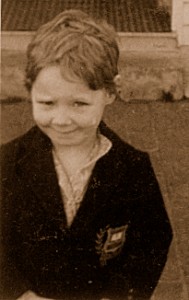 Addie has been around since we were around age 4. She was the ‘Cinderella child’ who emerged when others had been degraded into victimhood. Addie was a quiet, kind, generous, caring child whose talent is compassion. Often she would go so quiet as to be functionally selectively mute.
Addie has been around since we were around age 4. She was the ‘Cinderella child’ who emerged when others had been degraded into victimhood. Addie was a quiet, kind, generous, caring child whose talent is compassion. Often she would go so quiet as to be functionally selectively mute.
Addie has been made to be responsible for her abusers mental illnesses, addictions and for the abuse she has received. She was trained to endure and felt she had ‘died’ several times. She has endured degradation and bullying. Addie knew despair but retained hope.
The degradation episodes of having all her hair cut off to a crew cut and, stripped and put into our older brother’s clothes were acute episodes but in the aftermath these left Addie to live with the extended memory of these shaming episodes until our hair grew back. With a narcissistic mother, having curly/wavy hair versus having a rough crew cut meant she would be a ‘hidden thing’ until the hair grew back and a narcissist has no empathy for what they have harmed and for as long as the evidence of harm remains they deflect the blame for it onto the victim. The hopelessness Addie experienced in these extended episodes was compartmentalised into a boy alter which we later named Bobby. Bobby sustained these episodes for her.
The abuse of Addie was psychological, emotional abuse, physical and sexual abuse. She had also been forced to watch and participate in the torture of our cat, Figaro, when we were 3 and the torture and killing of several dogs and cats when we were 9-11 years old.
In late childhood Addie learned about Christianity and that she could pray to Jesus for help. She prayed daily to Jesus to save the animals, to protect her younger brother, to help her mother stop being ‘sick’, to stop the domestic violence of her father. When these prayers continually failed she prayed for Jesus to kill her (and so save her that way). That didn’t work either. As a result the only part of our team oriented toward Christianity cannot now believe in it.
Tied to a bed and endangered to a stranger at age 4, Addie felt she had been ‘killed’ during which time she left the body and this was where Katrina was born. Katrina looked down on Addie’s ‘dead’ body. Addie did, however, come back. She came back every time there was an animal to care for or help. She came back every time another alter had been harmed beyond endurance and had split, leaving the body with no driver.
At 6 years old Addie was given the role of mother to our baby brother. She adored him, loved him, and came to see herself as more than his big sister, she saw herself as his surrogate mother. But by the time this brother was 3-4 our abuser had showered him with repeated gifts and constant pandering to the point that he transferred all his loyalty to our abuser and, mirroring our abuser, began to demand Addie do everything he wanted, when he wanted, for as long as he wanted, or he’d scream for our abuser which of course meant another beating. Addie felt enslaved and progressively saw him as a corrupted extension of our abuser.
In late childhood, in front of her abuser, our younger brother would wipe his snot on Addie’s food, spit on it, and Addie would have to eat it, without complaint, showing no sign of fear. Then she would go and vomit it all up in the bathroom and did so for the next two years. Although she overcame the vomiting, Addie continued to battle compulsive food avoidance and compulsive self deprivation (a compulsion to prove she can survive deprivation).
Addie would have liked to have been a nurse or a kindergarten assistant. In late childhood to our early teens, Addie befriended stray animals. By our teens, Addie was bullied at school and then bullied in the various factories and shops we worked in. In our teens Addie was so traumatised by treatment in the family home that on returning to it she would literally freeze at the front gate, quaking and unable to step any further. It was like ‘shell shock’. It was alters like Marnie, toughened and ‘street’ who ‘saved us’ to the streets instead.
From our mid teens to mid 20s Addie endured domestic violence, rape, was made to be a ‘drug mule’ for one of our defactos, and conceded to ‘domestic prostitution’ as her ‘norm’. She countered this with a world of kindness and would stop to be kind to strangers: homeless people, elderly people, mentally ill and addicted people. On return to education from 18-24, Addie sought to become a welfare officer, social worker or OT. She became a volunteer, worked with homeless teens on the streets, in refuges and was approved to do emergency foster care when she was 22, providing crisis accommodation for 5 teenagers over a year. Addie is a Caretaker Protector Alter.
When we became an autism consultant Addie deeply enjoyed working with children and continued to envision she’d one day has foster children. When we married Chris, Addie made a ‘good wife’ and ‘homemaker’. Chris didn’t want children and much of my team did not want children of their own. Addie is the only one who still mourns that she never at least had foster children. However, she is a great contributor now as an art teacher and is a great cat-mum to our cats.
Addie has a strong sistership with Anne and a protective sistership with Carol and recognises Marnie as her sister. She sees herself as a sibling to all in the team and is a complete ‘team player’. She recognises our father as her ‘father’, recognised her mother as her ‘broken’ mother and as our abuser, recognises our brothers as her brothers and has empathy for the older brother and an attachment to our younger brother.
Addie’s alters are: SHIRLEY, MARNIE and BOBBY.
MARNIE:
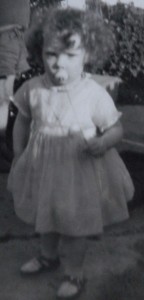 Marnie has been around since we were around age 3-4. She is a wild, anarchic, rebellious, tough child and willing to fight to the death. Her first memories are from around age 3 when we had been shoved into a coffin-like window seat in the living room and left in there for considerable time. Then she emerged regularly when we were being forced into the car around age 3-4. We were being taken across town to be tied to a bed in our abuser’s friend’s house where we were being endangered to a pedophile, but other times we were being left with different our mother’s sister Jean or with her aunt Gladys or told we were going to a Children’s Home. Marnie had fought the good fight and strove to avoid being put into the car much like you’d expect with imprisoning a feral Tom cat being taken to the vet.
Marnie has been around since we were around age 3-4. She is a wild, anarchic, rebellious, tough child and willing to fight to the death. Her first memories are from around age 3 when we had been shoved into a coffin-like window seat in the living room and left in there for considerable time. Then she emerged regularly when we were being forced into the car around age 3-4. We were being taken across town to be tied to a bed in our abuser’s friend’s house where we were being endangered to a pedophile, but other times we were being left with different our mother’s sister Jean or with her aunt Gladys or told we were going to a Children’s Home. Marnie had fought the good fight and strove to avoid being put into the car much like you’d expect with imprisoning a feral Tom cat being taken to the vet.
Marnie also did abandonment well. When we got locked outside in the rain one night when we were 4, Addie’s heart was breaking and Marnie emerged to handle it, taking it in her stride, treating it as ‘freedom’. Marnie had no problem taking herself to the park since we were around 3 years old and had no problem staying out all day. She missed nobody.
By the last two years of primary school, Marnie was taking out ‘retaliation’ on bullies, finding them alone and kicking them down stairs, pinning them to the wall with shoved tables, slamming their fingers with the lid of the desk. In short, if you meant us harm, then Marnie was likely a growing danger to you.
By high school, Marnie felt she had such a growing reputation she had nothing to lose. She began to fight those who taunted and bullies. Unable to hold back Willie would be in a panic inside, afraid Marnie would go too far and kill someone. At home Marnie had taken to drinking. With a bar stocked with all manner of alcohol, Marnie would help herself, taking port to school in a cordial bottle. To add to the mix we’d been put on sedatives to calm us down. The combination made Marnie derealised and probably as, if not more dangerous.
Progressively drifting to the streets, Marnie befriended older drinkers and drug users, binging and being picked up by police who knew we were homeless and would ask ‘so what’s your name today’ which was where we first heard Marnie give her name – Marnie Mc Keenan. Marnie handled the first de-facto, a stoner, and unlike Addie and Carol, never felt afraid or deeply despairing. Marnie fitted into the bogan life style, the risk taking, the anarchy.
On returning to education, Marnie went dormant, only to appear intermittently. There she’d break out, disappear for days on end, sleep here, sleep there, indulge this, try that. A picture of FASD, attachment disorder and ‘conduct disorder’. She understood rape, and she understood how to defend herself from the same fate. She carried a large carving knife in her boot. If anyone attacked her she would be Addie’s retribution. Luckily, nobody did and ultimately Willie banished Marnie as ‘too dangerous’. Nobody was allowed to acknowledge Marnie, to mention anything she did, to ever say her name. Though she broke through now and then with road rage that gripped everyone with fear and shame, she did remain largely dormant from there on until invited back in from exile by me in 2010. I determined that we would be safer if we all accepted and worked constructively with Marnie, with her story, her traumas, her rage. Once we did so we learned she was as human as the rest of the team.
Marnie is a powerful singer (she didn’t know that either) which emerged during a rock musical performance one night in 2009. She has a great affinity with horses, liked animals, enjoys the countryside and likes movies. Chris accepts her as much as anyone in the team and it is the first time she has felt fully known, accepted and loved for who she is, by me, by the team, by Chris and by our cats.
Marnie sees the team now as her siblings. She had great aversion to Addie which has given way to a great loyalty. She is very loyal to Chris and sees him as family. She felt connected to our mother’s aunt, Gladys, who we learned had looked after her since we were a baby. Marnie’s blunt and sardonic black humor has become more and more apparent and valued and her identity is very reflective of Gladys’ gritty, funny, yet vigilant nature. Marnie recognises our biological family as hers but feels disconnected from them all. Given the choice, she’d have best got along as Gladys’ foster child. She understands our mother, understands our mother’s own pathologies, understands that she never bonded with her and vice versa and has no need or desire to do so. Marnie is a Fighter and Protector Alter.
Marnie has no alters.
SHIRLEY
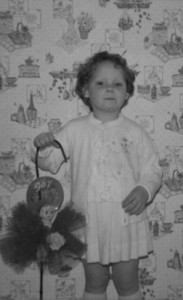 Shirley was the only part of the team with consistently positive memories of our mother – as her Mascot. Shirley only appeared in the body outside of the house, most specifically when down the shops between the age of 3-8 years old. Our mother had formed a good relationship with the next door neighbor, Dorrie, whose husband, Howard, ran his own butcher shop ten minutes drive from the house. Next door to his shop was a fruiterer’s ran by a Spanish lady named Maria. Both shop keepers doted on Shirley and this gave our mother the pride and belonging she needed in ‘being out with her daughter’. She would regularly take Shirley to the paint and wallpaper shop where she’d paw through the wallpaper books, to the haberdasher where she’d buy Shirley samples of ribbons, lace and brocade, to the hardware store where Shirley would ride on the electric horse ride, to the ice cream shop to share an ice-cream, to the doughnut shop to share donuts, to the big shopping centre to play on the climbing structure along with other kids, to buzz at the changing central sculpture, to visit the fabric market, to go to the pool shop with all its aqua blue fittings and smell of chlorine, to go to the supermarket where she’d get a toffee apple or a book, the the charity shops where we’d be bought clothes, later small statues, brush sets, manicure sets.
Shirley was the only part of the team with consistently positive memories of our mother – as her Mascot. Shirley only appeared in the body outside of the house, most specifically when down the shops between the age of 3-8 years old. Our mother had formed a good relationship with the next door neighbor, Dorrie, whose husband, Howard, ran his own butcher shop ten minutes drive from the house. Next door to his shop was a fruiterer’s ran by a Spanish lady named Maria. Both shop keepers doted on Shirley and this gave our mother the pride and belonging she needed in ‘being out with her daughter’. She would regularly take Shirley to the paint and wallpaper shop where she’d paw through the wallpaper books, to the haberdasher where she’d buy Shirley samples of ribbons, lace and brocade, to the hardware store where Shirley would ride on the electric horse ride, to the ice cream shop to share an ice-cream, to the doughnut shop to share donuts, to the big shopping centre to play on the climbing structure along with other kids, to buzz at the changing central sculpture, to visit the fabric market, to go to the pool shop with all its aqua blue fittings and smell of chlorine, to go to the supermarket where she’d get a toffee apple or a book, the the charity shops where we’d be bought clothes, later small statues, brush sets, manicure sets.
And primary school didn’t stop this. Through the first three years of primary school our mother would keep us home from school regularly and take us out to the shops. It was as though being at home, being alone, was what brought out all her addictions, all of her psychopathy, all of her madness and baggage, perhaps her own trauma. But being out, safely in front of the public, she could control herself, she could be someone she wasn’t at home.
Unlike Carol, Shirley was not shown off or treated like a doll. As Mascot, Shirley was treated as a ‘real child’, as a ‘normal child’. Shirley was quiet, probably never spoke, but she was easily entertained with food and experiences and objects and smells and textures and shiny things. Our mother didn’t feel like a ‘mother’ because there was no ‘going home’, no continuity. In that sense she was more like an aunt, a visitor, a big sister. But she was no monster, not out there. Shirley experienced her as enjoying Shirley’s company, enjoying the camaraderie, enjoying having ‘a friend’, enjoying being ‘accepted’ and ‘acceptable’, enjoying being part of a ‘normal world’, a world far removed from the domestic violence and compulsive womanising she endured from our father, a world far removed from the boredom of being a 1960s house wife, a world far removed from being his charity case in which he’d ‘done the right thing’ and stuck by the teenager he’d impregnated and who now, in her 20s had two children to him, a world away from her compulsive gambling and alcoholism. It was not even a world in which my team were the imposition upon her symbiotic relationship with our older brother. He was in school, entrusted to the care of others, lost to the world. This was our honeymoon, her chance to transfer some of that to a child who was not yet in school or more easily taken back out whenever she needed ‘a friend’.
But around age 9, Shirley was gone. Our mother had well and truly quit any interest in being ‘normal’ and was on a different track now. One of affairs and doing whatever wild and decadent thing she could do to maintain her love interests. Shirley had no place with this new woman. The old one was gone. From 8 years old we were sent to the newsagent to buy our own birthday card and write on it to ourselves.
As an adult Shirley was the only one of the team who ever missed our mother. But the one she missed had been gone for decades and Shirley knew that this one would never be the one she’d known.
Shirley still emerges now and then at the shops. Her memories were like a blasphemy to the others in the team and were suppressed and defended against. Since my return in 2010 I’ve worked to help the team feel safe with Shirley, to feel that Shirley’s memories are no threat to them, no denial of the equally valid realities they have each lived. Finally, Shirley is accepted by the team, her memories respected and she is allowed to value them. Shirley would not strike people as particularly autistic. Shirley, like Rose, is another Apparently Normal Part.
Shirley felt she our mother was her mother but had little relationship with any other biological relatives. In this sense she was the only child of a single mother. Shirley feels at home now with the team and with our husband Chris.
Shirley has no alters.
BOBBY/LEE
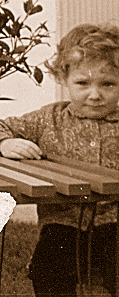 Lee probably began to re-emerge when we were around 10-11 when there was a psychological abuse campaign between our abuser and our older brother to confuse us about our gender. It was a ‘game’ our abuser was getting into in which she’d pretend it was a secret Lee was over hearing about how ‘she doesn’t realise she’s actually a boy’. Around this same time, in spite of the family having plenty of money, we were being given our older brother’s PJs (complete with male opening flap) to wear which, with no positive connection to him whatsoever, we found emotionally and psychologically overwhelming. In response Lee had got a morning paper round at the local newsagent in order to buy some clothes (and bought a pair of jeans, a t-shirt, a duffle coat).
Lee probably began to re-emerge when we were around 10-11 when there was a psychological abuse campaign between our abuser and our older brother to confuse us about our gender. It was a ‘game’ our abuser was getting into in which she’d pretend it was a secret Lee was over hearing about how ‘she doesn’t realise she’s actually a boy’. Around this same time, in spite of the family having plenty of money, we were being given our older brother’s PJs (complete with male opening flap) to wear which, with no positive connection to him whatsoever, we found emotionally and psychologically overwhelming. In response Lee had got a morning paper round at the local newsagent in order to buy some clothes (and bought a pair of jeans, a t-shirt, a duffle coat).
However, Lee first actually announced himself by name when we were almost 13 and at our first high school. It was soon after Carol had been raped in our bedroom aged 12 and around the same time as our abuser had now given us two of her own short mini skirts to wear to high school (which felt shaming and overwhelming and made us desperate to not be female). Lee was filled with apathy, resentment, hopelessness, teenage angst. He insisted everyone now call him Lee. Nobody would.
Lee did homelessness from around age 13-15 and felt life was ‘shit’ and didn’t care if he lived or died, it didn’t ‘matter’. Smoking, drinking, was normal, he’d grown up around it. Going into pubs was normal. From 8-15 our family’s house was like a pub with a snooker table, bar, music and parties every Friday and Saturday night. So Lee gravitated toward pubs.
Lee went dormant when we lived with men from 15-21 then emerged for a time when we shared a house with our friend Scott. When Lee’s army clothes were all discarded as ‘sending out the wrong message’, Lee went dormant again. Lee re-emerged around 2012, shocking me with his behaviour and attitude. I had no idea who this alter was and Lee refused to communicate with me. Finally I guessed this was Lee from when we were 13.
Eventually I learned that Lee had once been Bobby, a silent, demoralised, degraded, little boy (the direct and deliberate antithesis to the ‘golden child’ role our mother assigned our older brother). Bobby sustained Addie’s misery and hopelessness when were were 3-4 years old. Lee believe that Bobby had ‘been killed’ when he was 4 and that Lee then found himself present in late childhood but nothing like he had been when he was Bobby. Bobby was an alter who believed/s he was killed – a ‘Dead Alter‘.
Our mother would continually tell a story of a boy doll named Bobby which we’d had since we were 2 years old. She would tell people that when we were 4 we had got our older brother to help us ‘kill Bobby’, that together we had smashed in the doll’s head, hidden it in the doll’s pram, taken a knife and slashed up the roof of the doll’s pram. As an adult, our older brother told us this was not true, that he alone had apparently done this and blamed what would have been Carol.
Our mother would not have handled such a blatant expression of Carol’s lack of ‘gratitude’ for the kinds of toys she felt deprived of all her own childhood. We have no memory of what ensued. At this same age we had a cigarette put out on our leg and were hit over the back with a lump of wood and thrown several times at the wall. Perhaps this is what ‘killed Bobby’. In any case a part of Bobby must have decided the only way to not be killed was to become ‘like our older brother’ and so, perhaps, when Bobby was able to re-emerge it was impossible to do so as the kind of person who would easily be ‘killed’.
Lee is an Introjection of the maleness of what is probably my mother’s ‘Bogan Boy’ alter. This was probably because in late childhood the only way to survive potential serious danger was for this part to completely concede to being a boy and take on a mirror image of one of my mother’s alters to minimise potential for more harmful abuse. Lee is also an ‘Apparently Normal Part‘.
Lee ‘doesn’t mind’ our father but doesn’t see him as a father, feels no connection to our mother or our brothers.
Lee has no alters.
KATRINA
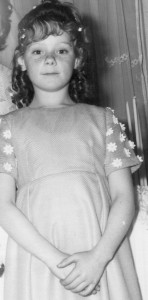 Katrina emerged when we were 4. She was above the body that Addie had left. It was tied to the bed, being abused by a man we had been endangered to. Katrina then disappeared and re-emerged when we were in late childhood in a house filled with endangerment in a time when our mother was avidly interested in all things ‘occult’. When our father was away on shooting and fishing trips up the bush, our mother would now sedate our little brother with Valium and throw her own small parties. These involved people from her teens, including the friend whose house she’d used when endangering us to a pedophile when we were 4. Nobody in the team remembered these people, but Katrina did.
Katrina emerged when we were 4. She was above the body that Addie had left. It was tied to the bed, being abused by a man we had been endangered to. Katrina then disappeared and re-emerged when we were in late childhood in a house filled with endangerment in a time when our mother was avidly interested in all things ‘occult’. When our father was away on shooting and fishing trips up the bush, our mother would now sedate our little brother with Valium and throw her own small parties. These involved people from her teens, including the friend whose house she’d used when endangering us to a pedophile when we were 4. Nobody in the team remembered these people, but Katrina did.
Put on sedation by the GP, Anne was in a ‘sleepwaker’ state. Anne had regularly woken in night terrors, having sleep walked through the house. The usual paralysis that should accompany sleep had become broken. Anne was capable of playing out a nightmare. The problem was that drunken people enjoying games can decide to play with a sedated sleepwalker.
Katrina entered into Anne’s dreams warning Anne about things that were happening to her and around her in the room as she slept. In particular, Katrina was warning Anne that our little brother was in danger from Anne. That as Anne slept, sedated, people were seeing if they could control her through suggestion. Thanks to Katrina, Anne knew she had to ignore what she was being told to do.
Once awake Anne became progressively hypnotised by Katrina speaking to her from outside of her. Eventually, Willie because afraid of Katrina’s effect on Anne and took over from Anne, effectively blocking Katrina’s avenue of influence. It was in 2010 that Katrina was finally welcomed back and as she accessed the body and was able to speak, this was the first time she learned she too was not a ghost.
Katrina is still largely dormant. She now knows her history and that she is welcome. She relates to gypsy music and all things Spanish, plays beautiful classical improvisations on the piano. She is among the most intuitive and sensing of our team. Katrina was another Observing Emotional Part and Protector to Anne.
Katrina feels at home now with the team, feels an alliance now with Willie, feels the same sisterhood with Anne and like a guardian to Addie. She feels at home with our husband Chris.
Katrina has no alters.
All of these alters were split off parts of me which continued a lived existence in my absence. We are all multiple, just most people achieved integration of all their components of self into the core of their identity and in my case there was such a torrent of challenges that this natural integration did not happen and was actively derailed. I am multiple but as whole a person as any singleton. We all deserve a life out of the closet. This is what I claim for myself and my team.
I recognise multiplicity in my father. He was several different unintegrated people: Jackie Paper, Sparkling Arkie, Johnny Williams, Wild Dog Dingo, Poor Boy. Mothers can also have DID. Whilst I recognised many things in my mother over the years I knew her: psychopathy, Munchausen’s by Proxy, Borderline and Narcissistic Personality Disorders, Addictions, Mood/Anxiety/Compulsive disorders, Aspergers… it is also possible that among her challenges, that she was also multiple.
I could see our abuser as evil. However, Psychopathy, Munchausen’s, Narcissistic Personality Disorder, Borderline Personality Disorder, Pedophilia, Addictions… all these things can present and impact upon others as evil. But the fact is they are the ‘uglier’ mental illnesses and we must face their existance. Most who have these things don’t like themselves either, often they hate themselves and this hatred comes out in how they compensate through further harming themselves and others, avoiding responsibility, avoiding acknowledgement, avoiding professional help.
Donna Williams, BA Hons, Dip Ed.
Author, artist, singer-songwriter, screenwriter.
Autism consultant and public speaker.
http://www.donnawilliams.net
I acknowledge Aboriginal and Torres Strait Islander people as the Traditional Owners of this country throughout Australia, and their connection to land and community.
